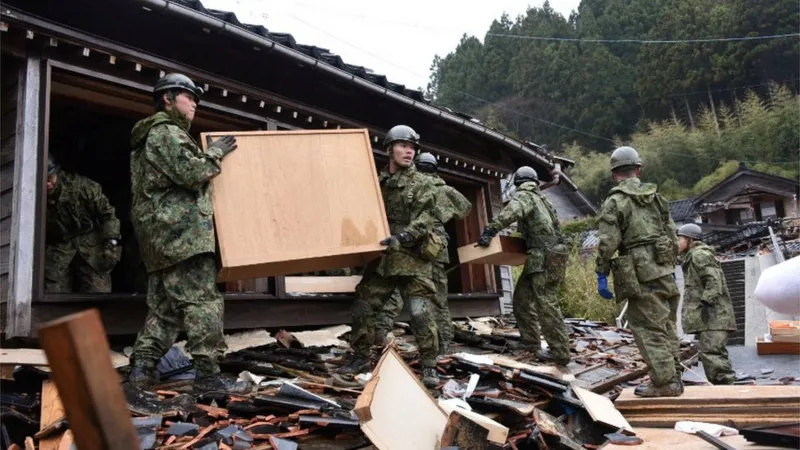A woman in her 90s has been found alive under rubble five days after a devastating earthquake struck central Japan.
Rescue workers discovered her in the wreckage of a two-storey building in the town of Suzu.
The 7.5-magnitude earthquake struck the Japan Sea coast on Monday, flattening towns on the remote Noto peninsula.
More than 120 people have been confirmed dead, and 200 are missing.
According to the newspaper Yomiuri Shimbun, 100 rescuers were sent to the town of Suzu after learning that two women were buried alive.
Citing local police sources, the newspaper reported that the elderly woman was responsive, but believed to be suffering from hypothermia.
At the same site, rescuers also found a woman in her 40s in a state of cardiopulmonary arrest, reports said.
The first 72 hours of a rescue operation are considered critical because after that, the chances of finding people alive drops substantially. The two women were found days after that window closed.
Japan's Self-Defense Forces are using helicopters for rescue operations and deliver supplies to isolated areas, as several roads remain blocked.
According to public broadcaster NHK, rescue efforts could be hampered by wet weather forecasted for Sunday in some quake-hit areas, with authorities warning that even a small amount of rain could trigger more landslides.
They also warned that a cold front is expected on Sunday, which could bring snowfall through Monday in mountainous areas of the quake-hit Ishikawa prefecture.

More than 30,000 people are being housed in government shelters.
As of Saturday, around 23,200 households were without electricity in Ishikawa and more than 66,400 lacked running water.
Ishikawa's governor Hiroshi Hase said during a disaster management meeting that the prefecture was facing "extremely severe situations".
He also warned that restoring running water would take a long time "as many water pipes have cracks".
Some hospitals and facilities for taking care of elderly and disabled people have also lost power and water.
Japan is one of the most seismically active countries in the world, and activity has been increasing around Noto since the end of 2020. More than 500 small and medium earthquakes have hit there over the past three years.
Latest Stories
-
Paris 2024: Opening ceremony showcases grandiose celebration of French culture and diversity
3 hours -
How decline of Indian vultures led to 500,000 human deaths
4 hours -
Paris 2024: Ghana rocks ‘fabulous fugu’ at olympics opening ceremony
4 hours -
Trust Hospital faces financial strain with rising debt levels – Auditor-General’s report
5 hours -
Electrochem lease: Allocate portions of land to Songor people – Resident demand
5 hours -
82 widows receive financial aid from Chayil Foundation
5 hours -
The silent struggles: Female journalists grapple with Ghana’s high cost of living
5 hours -
BoG yet to make any payment to Service Ghana Auto Group
5 hours -
‘Crushed Young’: The Multimedia Group, JL Properties surprise accident victim’s family with fully-furnished apartment
6 hours -
Asante Kotoko needs structure that would outlive any administration – Opoku Nti
6 hours -
JoyNews exposé on Customs officials demanding bribes airs on July 29
7 hours -
JoyNews Impact Maker Awardee ships first consignment of honey from Kwahu Afram Plains
8 hours -
Joint committee under fire over report on salt mining lease granted Electrochem
8 hours -
Life Lounge with Edem Knight-Tay: Don’t be beaten the third time
8 hours -
Pro-NPP group launched to help ‘Break the 8’
8 hours

